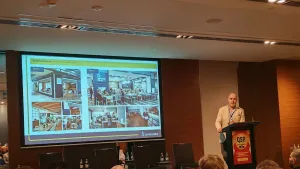
3 workforce trends and how QSRs can cash in
From managing multiple venues to understanding labour costs, there are several opportunities for QSRs.
Workforce management in the quick service restaurant industry is fraught with challenges, from staffing levels and absences to correctly paying employees and keeping them engaged. But there are also opportunities for those who can master the art of workforce management.
In this article, we'll explore some of the challenges and trends in workforce management for QSRs, as well as what opportunities exist for those who can overcome these challenges.
The 3 biggest challenges in workforce management
As soon as a new restaurant opens its doors, the clock starts ticking on workforce management. And because quick service restaurants tend to have high turnover rates, the challenges can be magnified. Below are three of the biggest challenges faced by QSRs when it comes to workforce management:
Staffing levels and absences
One of the biggest challenges facing QSRs is staffing levels and absences. Because turnover is so high, there are often not enough employees to cover shifts. This can lead to long lines and frustrated customers.
COVID-19 has only made this challenge more difficult. Post-pandemic, many QSRs are struggling to find enough employees to cover shifts. The reopening of the economy has led to an increase in job openings, but not enough people are applying for these positions.
Correctly paying employees
Another challenge facing QSRs is correctly paying employees. Whether it's minimum wage or overtime, QSRs need to make sure they are paying their employees correctly. Otherwise, they run the risk of lawsuits and bad publicity.
This has become even more difficult in recent years due to the increasing number of awards and the changing rules around them, and because of the different rules that apply to full-time, part-time, and casual employees. COVID-19 has only made this more difficult, as well, with changes to the rules around shifts and breaks.
Staff engagement and communication
A third challenge facing QSRs is staff engagement and communication. With such high turnover, it can be difficult to keep employees engaged and motivated. This can lead to a decline in service quality and customer satisfaction.
This is especially true in the post-pandemic world, where many QSR employees tend to be working reduced hours or are on furlough. It's important to find ways to keep employees engaged and motivated, even when they're not working.
Opportunities and trends
While it may seem like the challenges of workforce management are insurmountable, there are also opportunities that exist for those who can overcome them. Redcat, a leading provider of hospitality software for QSRs, has identified three trends that are providing opportunities for QSRs when it comes to workforce management.
Based on these trends and more, Redcat works with Deputy to help QSRs overcome the challenges of workforce management. From managing multiple venues to understanding labour costs, Deputy provides the tools and features QSRs need to manage their workforce effectively.
From managing time to managing people
Over the course of history, workforce management systems have predominantly focused on time management such as schedules and time clocking. Today, however, the industry is shifting its focus to people management from record-keeping to communication and managing/surveying staff engagement.
“Being able to make sure that labour is appropriately rostered and optimised is a massive payoff. Then try putting a dollar amount on better employee engagement and customer satisfaction,” said San Churro owner Giro Maurici on how managing people can bring massive benefits to a QSR.
Deputy provides:
- Streamlined, digital onboarding that collects all documentation remotely
- Streamlined communication through the News Feed, with features such as ‘read confirmation’ to ensure that all-important information is seen
- The ability to roster teams between different locations under one company, so employees always know where they need to be and when
- Process, operational, and reporting transparency and consistency across multiple venues
Smart scheduling
As technology continues to permeate the workforce, we are seeing the rise of smart scheduling technologies. These technologies involve setting up rules for scheduling and then letting a software solution suggest a data-driven solution. Artificial intelligence (AI) is being used more and more to create these optimised schedules based on data, such as sales data, weather data, and staff availability.
Deputy provides:
- Fill shifts with one tap - Roster qualified staff, make sure you have the right coverage across the week, and find last-minute replacements with one tap.
- Shift pulse to help managers check in on their team during their shift and ensure they are on track
- Shift equality to make sure employees are rotated through different shift patterns fairly
- Employee first features such as the ability to view their schedule on their mobile and clock in and out via the app
- Award compliance, including ensuring work-life balance for employees such as minimum gaps between shift
Mobile- and digital-first
Another trend that is providing opportunities for QSRs when it comes to workforce management is the shift to mobile-first. With the majority of the workforce now owning a smartphone, mobile apps are becoming the preferred way to access information and communicate.
This shift to mobile has led to the development of new workforce management software solutions that are designed specifically for mobile. These solutions make it easier for employees to clock in and out, view their schedule, and communicate with their manager – all from their smartphone.
Redcat and Deputy also offer integrations with leading point of sale (POS), payroll, and learning management system (LMS) platforms to reduce double handling of data and create more actionable insights across the business.
Redcat's workforce management software for QSRs
Redcat and Deputy’s collaboration is designed to help QSRs overcome the challenges of workforce management. From managing multiple venues to understanding labour costs, Deputy can help QSRs manage their workforce effectively.
To learn more about how Redcat and Deputy can help your QSR business, contact Redcat today.






















